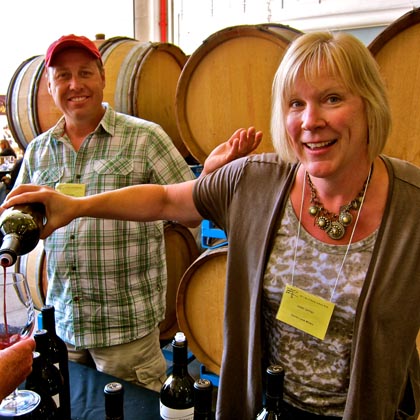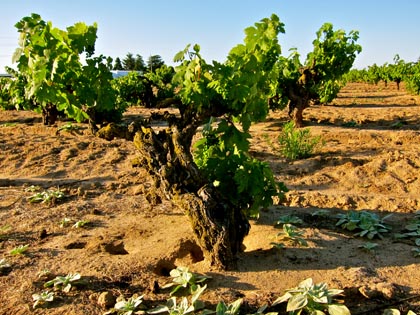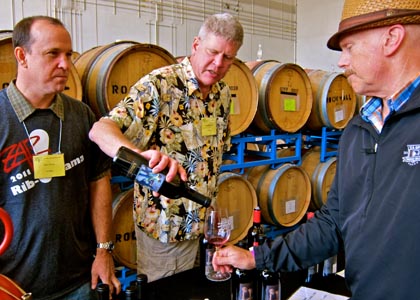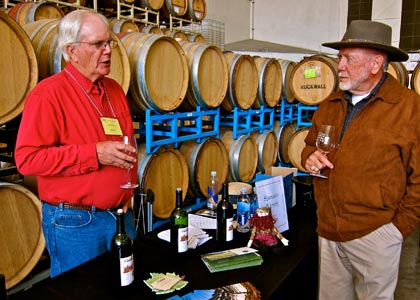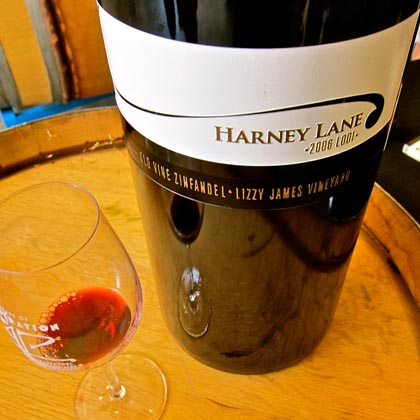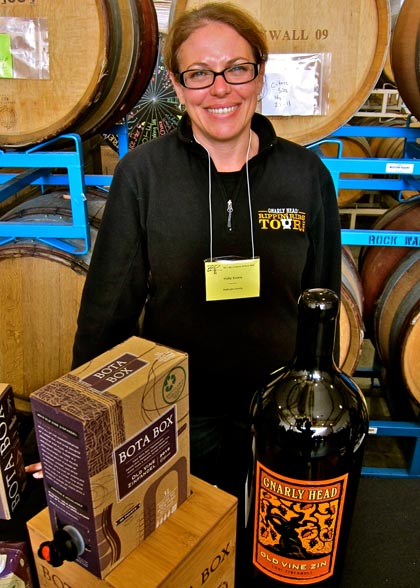Letters from Lodi
An insightful and objective look at viticulture and winemaking from the Lodi
Appellation and the growers and vintners behind these crafts. Told from the
perspective of multi-award winning wine journalist, Randy Caparoso.
Lodi shines at Zin Rib-O-Rama
Harney Lane's Kyle & Jorja Lerner showing the love ZAP's Rib-O-Rama
Spelling out what makes Lodi Old Vine Zinfandel special…
Last weekend on July 9, Lodi was the American Viticultural Area featured by Zinfandel Advocates & Producers (a.k.a. ZAP) at its first ever annual Rib-O-Rama, taking place at Rock Wall Wine Company in Alameda, along the foggy banks of the San Francisco Bay. Rock Wall is a fairly new Zinfandel specialist, owned and operated by Kent Rosenblum (perhaps best known, and revered, as the founder of Rosenblum Cellars, which he sold in 2008) and his daughter Shauna Rosenblum (Rock Wall’s winemaker).
Along with Rock Wall, there was a handful of other East Bay based wineries present at the Rib-O-Rama, but it was the luscious, juicy Zinfandels of Lodi that ZAP wished to highlight as the ideal matches for, of course, all the variations of that great American summer prediliction: barbecued ribs. And there were pork, beef and lamb ribs aplenty, cooked in myriad spices and seasonings, for zin lovers to enjoy at the Rib-O-Rama. For some detailed notes on the Lodi Zinfandel bottlings tasted at this event, please see the end of this blogpost.
100 year old dry farmed zin in Lodi's eastside sandy loam
For Zinfandel lovers who missed out, or who are not quite in the know: the Lodi AVA is home to over 40% of the 49,000-plus acres of Zinfandel grown in California (Zinfandel is California’s second most widely planted red wine grape, trailing Cabernet Sauvignon’s 75,000-plus acres).
Lodi is especially known for its Old Vine Zinfandel. For connoisseurs, the unofficially defined term, “old vines,” generally refers to wines sourced from vineyards dominated by plants that are minimum of 40 to 50 years old (contrary to common assumption, typical old vine vineyards everywhere around the world actually consist of vines of variant ages because individual plants invariably die off, requiring “dead spots” to be filled with replantings from time to time).
At ZAP’s Rib-O-Rama, for instance, there were Lodi grown wines sourced from vineyards originally planted in 1901 (St. Amant’s Marian’s Vineyard), 1904 (Harney Lane’s Lizzy James), circa-1910 (Macchia’s Oblivous), and 1916 (m2’s Soucie Vineyard). That’s old. Then again, there are a numerous other esteemed Zinfandel plantings dating back to the turn of the last century in California’s Sonoma, Napa, Contra Costa and Amador counties; but what makes Lodi’s ancient plantings unusual is that many of them are still cultivated on their own rootstocks, rather than grafted onto St. George rootstock (from the American grape species, Vitis rupestris St. George), which was favored along the North Coast because of its resistance to phylloxera (the root louse that decimated European and Californian wine vineyards in the late nineteenth century) and ability to thrive in dry farmed conditions.
m2's Layne Montgomery pouring at Rib-O-Rama
St. George, of course, has also been commonly used in Lodi, but the reason thousands of acres of ungrafted Zinfandel in Lodi exists despite the presence of phylloxera is because of the deep, rich Tokay Sandy Loam that dominates the Mokelumne River section of the Sacramento-San Joaquin River Delta. More precise: because phylloxera generally favors water retentive topsoils, and Lodi’s loams are rich and well drained enough to allow for deep, healthy root penetration, many of Lodi’s plantings remain impervious to this sap sucking insect to this day. The deep, sandy soils of Chile are another good example of a wine region in which ungrafted vines have done just fine; and other than pockets of sand dune-like soils in Contra Costa and Santa Barbara, Lodi’s heritage vineyards represent the largest stand of own rooted vines in the state.
This is not to say that own rooted Zinfandel is the best. St. George makes a terrific rootstock match for Zinfandel, and is still commonly used in replantings today. Far more important is the fact that older vines also tend to be head trained, with spurs protruding from all sides — making plants look more like individual bushes — rather than trained on trellises. Head training was the common practice of our viticultural pioneers, who loved the resiliency and flavor of Zinfandel. They knew back then, just as we know now, that the advantage of head trained vines has to do with Zinfandel’s relatively thin skin — prone to sunburn or raisining — plus its distinct habit of producing uneven sized berries. Because the smaller berries within a Zinfandel cluster might begin to raisin before the larger berries can attain a physiological ripeness of flavor and sugar/acid/pH balance, it helps to head train Zinfandel because this creates a more circular canopy of leaves that protects the clusters from accelerated ripening or burning (most wine grapes ripen ideally in steady, dappled sunlight) — an advantage that trellised vines, slightly more exposed on two sides, might not enjoy, unless the rows are perfectly oriented to movements of the sun and canopies are rigorously worked.
St. Amant's Joel Ohmart unleashing hell...
The disadvantage of head trained vines: they must be cultivated and picked by hand; and in this day and age of rising costs, dwindling qualified labor and competitive market pricing, trellised vines that can be maintained and harvested by machines only make sense. Which brings us to the other reason why Zinfandel from Lodi’s ancient head trained vines are excelling in the market today: because of the region’s long, consistent agricultural heritage, the vast majority of these prize vineyards have been owned and farmed by the same families who began arriving as early as the late 1850s, simultaneous with the Gold Rush. Consequently there are more third, fourth, fifth, and now sixth generation wine grape farmers in Lodi than in any other region on the West Coast, period. This factor plus long established vineyards on lower cost real estate, adds up to this basic fact: to get the quality comparable to today’s finer Lodi Zinfandels in the $12 to $30 range, you have to spend $25 to $65 for Zinfandels from Napa Valley or Sonoma County.
Finally: there is, admittedly, a lingering stigma against Lodi grown wines; primarily due to the erroneous notion that, because the AVA is located between the North Coast and the Sierra Foothills, it is a hot, desert-like Central Valley region, good only for lower quality bulk wine. Nothing could be further from the truth; especially when you consider that Lodi is located south of Sacramento (one of the greenest looking cities in California) and north of Stockton (which is actually a seaport). Although Lodi is technically at the northern end of California’s Central Valley, its terroir is more of a Delta influenced region possessing a breezy Mediterranean climate, warm yet very moderate — its growing seasons roughly akin to the middle of Napa Valley (between Oakville and St. Helena, where many of California’s most prestigious are grown) and Sonoma’s Alexander Valley.
Spenker's Chuck Spenker talks his rustic zin
Don’t take our word for it: as Ehren Jordan, winemaker of Turley Wine Cellars — producer of undoubtedly the most prestigious (and certainly the most coveted) Zinfandels in the state — has recently shared in conversation, “Lodi is consistently cooler than St. Helena… we always pick our grapes in St. Helena earlier than our Lodi grapes. Anyone who thinks Lodi is a hot Central Valley region just don’t have his facts straight.”
Sure, Lodi has traditionally been, and still is, a huge source of grapes for the big wine producers like E&J Gallo and Woodbridge by Robert Mondavi. But that’s because the rich soils in much of Lodi have always lent themselves to consistent, and cost effective, winegrowing; not because it’s a “hot” climate. Also consider the fact that up until the seventies, over half the grapes grown in Napa Valley still went to the Gallo co-op, and most of the rest to good sized wineries like Louis Martini, Charles Krug, Inglenook, Robert Mondavi and Beringer: in the history of California winegrowing, the fact that regions supplied big wineries has never been an indication of lower quality, but rather the simple fact that grapes grow well there.
But make no mistake, folks: there are still far more brands of top quality Zinfandel coming out of Sonoma County than there are from Lodi. The Delta is just catching up. Compared to Napa Valley, Lodi’s ultra-premium wine rep is barely into adolescence, even if way past incubation. Prestige vignerons like Larry Turley, Patrick Campbell (former owner of Laurel Glen), Dan Lee (Morgan Winery), and “boutique” sized wineries within Lodi itself (like m2, Macchia and St. Amant), have been working the region only within the past ten, fifteen years. So if you haven’t quite “caught up” to the terrific wines Lodi has been producing lately, who can blame you? Lotsa wines in the sea.
But if you relish genu-wine, classic old vine Zinfandel, take a gander at these current releases shown by some of Lodi’s finest at the 2011 ZAP Rib-O-Rama:
2008 Harney Lane, Lodi Zinfandel ($22) – Luscious raspberry aroma; plump body, on the soft and uncomplicated side, yet teeming with irresistable, lush, fruit forward Zinfandel flavors.
2008 Harney Lane, Lizzy James Lodi Old Vine Zinfandel ($33) – Fragrant combination of raspberry and dried cranberryish aromas, just coming out of youthful reticence; full, firm yet round and juicy in the middle, launching broadsides of loam tinged berry flavors.
2008 m2, Soucie Vineyard Lodi Old Vine Zinfandel ($28) – Juicy berry and earth toned aromas, hinting at mushrooms and woodsmoke; feel is round, fruitful, yet with a certain amount of elegance in its sense of balance — like crisp hospital corners — on the palate.
2009 m2, Artist Series Lodi Old Vine Zinfandel ($35) – Red berries, cola and scrubby earth tones in the nose; medium-full, lush and velvety in the middle, narrowing into a proportionate feel in the finish.
2009 Macchia, Voluptuous Lodi Old Vine Zinfandel ($24) – Sweet cherry and wild, red berryish fruit in the nose; very big (if you don’t like a full alcohol, steer clear), fruit stuffed, unabashedly ripe, rather fat if indeed “voluptuous,” in the mouth.
2009 Macchia, Serious Lodi Old Vine Zinfandel ($50) – A limited quantity, reserve level barrel selection; pungent with raspberry and Bing cherry aromas, charged with toasted oak qualties; ripe, aggressive varietal fruitiness manifested on the palate, which thick and muscular with tannin, still protruding past a velvet veneer.
2009 Michael~David, Windmill Lodi Old Vine Zinfandel ($12) – Sold only at the winery, making the trip out to the Phillips Fruit Stand, Café & Tasting Room all the more worthwhile, since you’d be hard pressed to find a better value. Well ripened wild berry aromas are definitely tinged by smoky/charred oak qualities — engaging even if you’rea zin-fruit purist — with plump fruit flavors treading softly on the palate.
2008 Michael~David, Lodi 7 Deadly Zins ($16) – The cuvée now found everywhere Zinfandel is sold, from Tokyo to Tehachapi, Miami to Malmoe, yet always a goodie; the ripe berry flavors faithfully laced with peppercorns, cardomom and cinnamon spices; soft, silky, easy drinking — the waify girl you can’t help digging.
2009 Michael~David, Earthquake Lodi Old Vine Zinfandel ($26) – This bottling has become somewhat iconic — take it or leave it, buddy — in its manly, meaty, oak and tannin driven musculature. The oakiness is sweet, almost coconut-like, with charred undertones, yet packs just as much ripe, black and red berry fruitiness onto its sinewed back.
2009 St. Amant, Marian’s Vineyard Lodi Old Vine Zinfandel ($24) – Marian’s is tightly demeanored at the moment; raw meat and leather notes engulfing dark berry aromas and flavors, buried in a fullsome, voluminous body.
2008 Spenker, Rustic Red Lodi Zinfandel ($16) – They’re not kidding when they say “rustic” — you have to like somewhat of an old timey, earthy, beef consommé-like style of Zinfandel to appreciate this — mixing the varietal berry qualities with hay-like notes, plopped upon a smooth, easy, medium weight body.
2007 R&B, Swingsville Lodi Zinfandel ($12) – Value pricing with modicum of intensity; very bright, fragrant cherry/berry perfume with sweet tea nuances; peppery and smoky oak qualities come emerge in the mouth, commingling with the fruit in a lean, medium-full body.
2008 Gnarly Head, Lodi Old Vine Zinfandel ($12) – Like an open book — a plump berry and flowery fruitiness — hanging ten in the mouth like a fat guy with unsuspected agility, yet finishing dry, medium-full, with moderately firm tannin.
DFV's Holly Evans showing Gnarly Head
